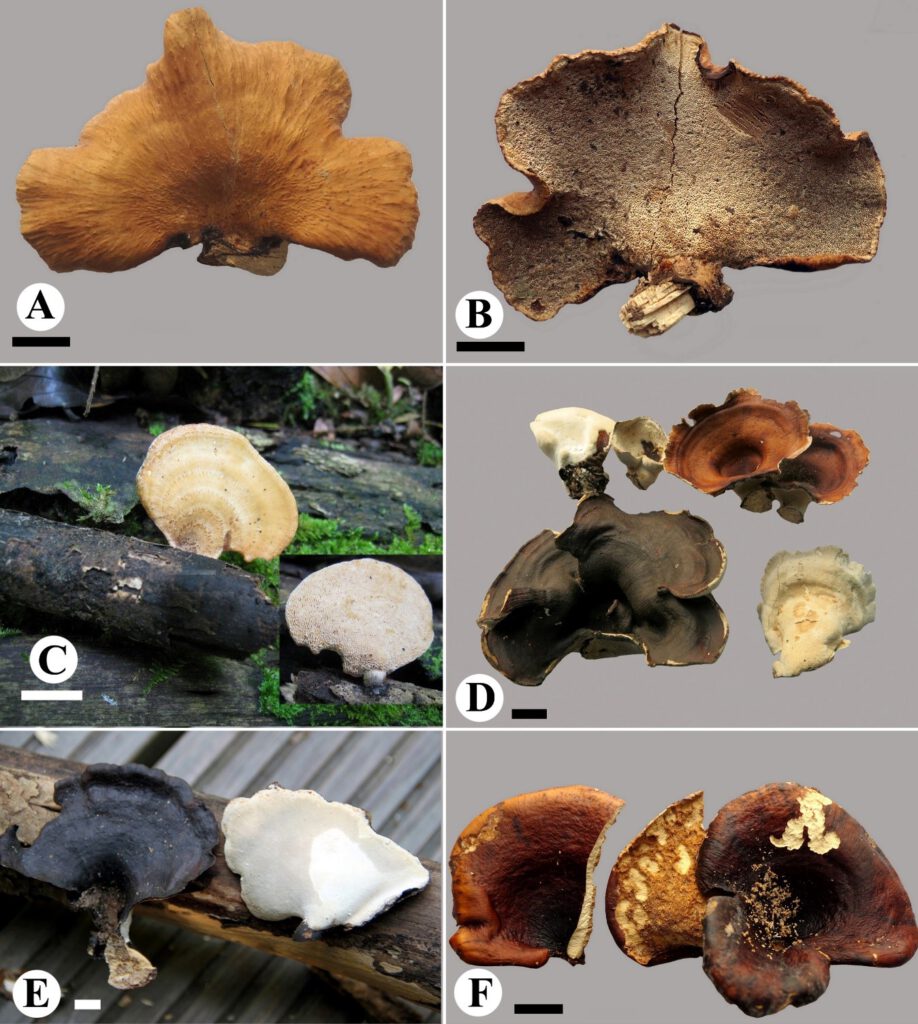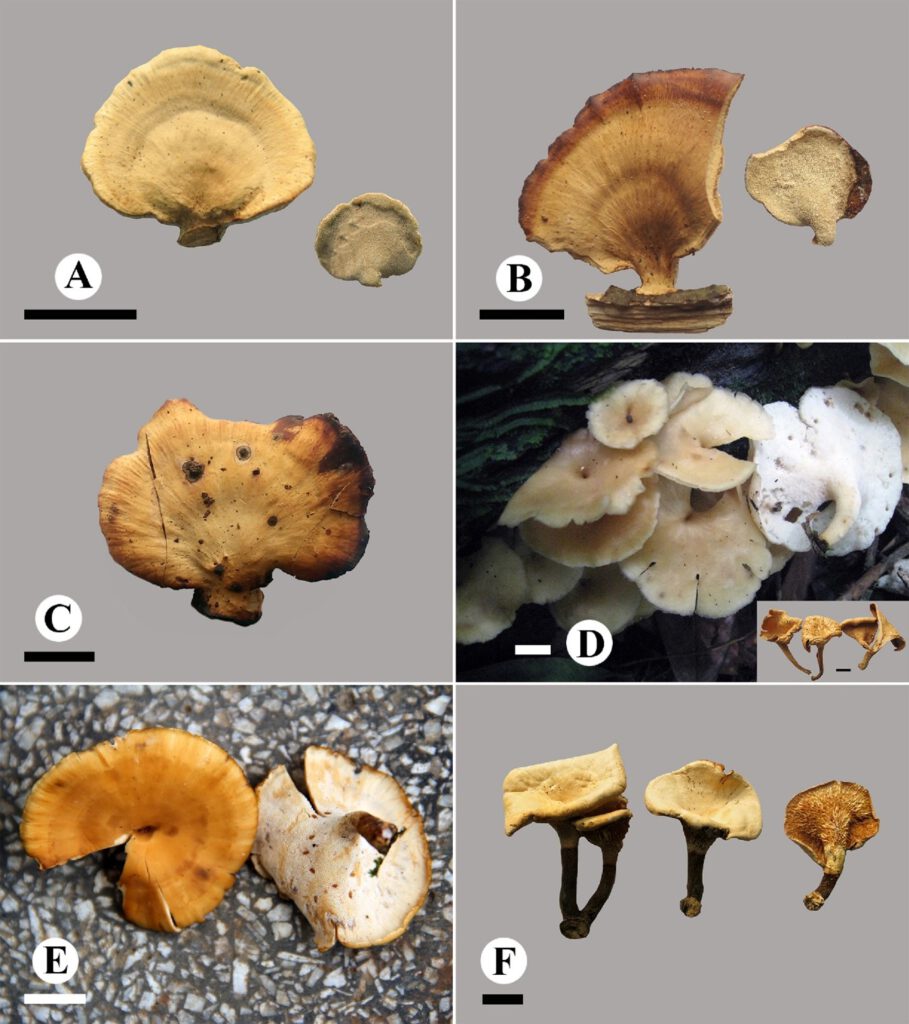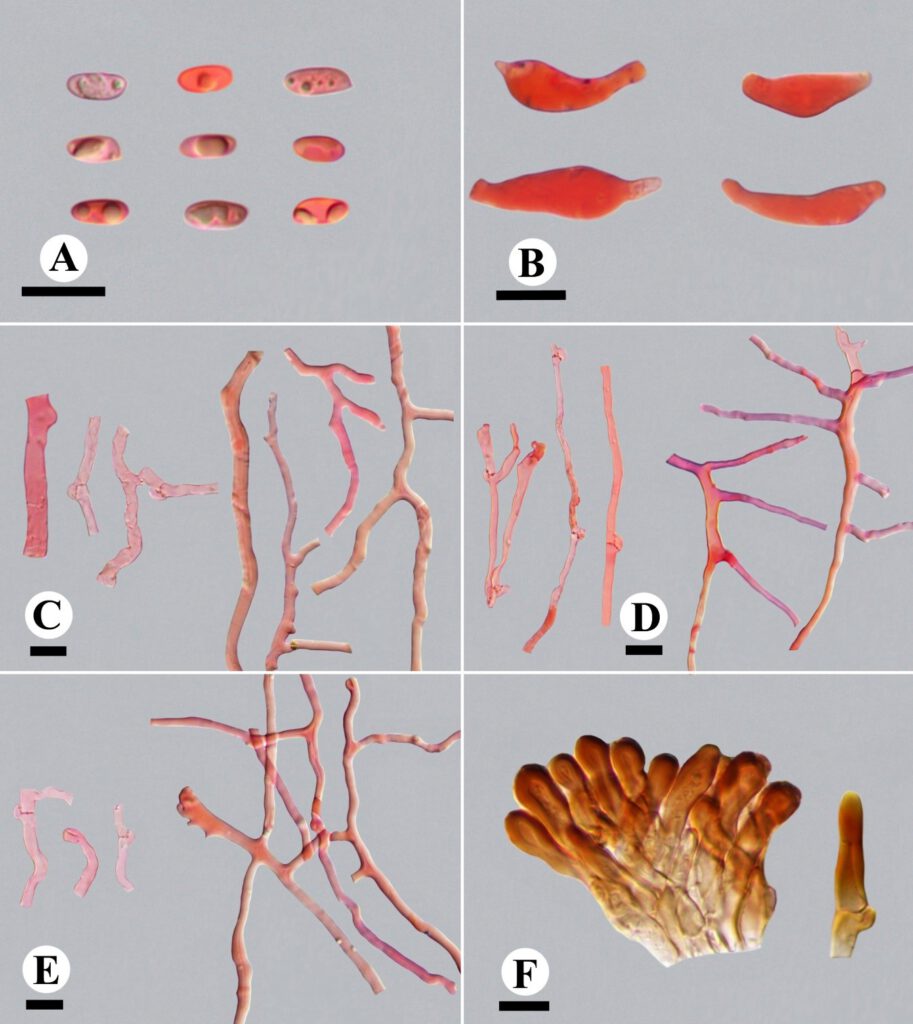Picipes ailaoshanensis B.K. Cui, Xing Ji & J.L. Zhou, sp. nov.
MycoBank number: MB 559395; Index Fungorum number: IF 559395; Facesoffungi number: FoF 10644;
Description
Basidiomata – Annual annual, laterally stipitate, solitary, woody hard when dry. Pilei irregularly fan-shaped to semicircular, about 1.6–3.6 cm long, 1.8–5.6 cm wide and up to 5 mm thick at base. Pileal surface yellowish brown to chestnut when dry, glabrous or covered with protuberances towards the stipe, azonate, frequently with radially aligned stripes; margin straight or incurved when dry. Pore surface grey beige when dry; pores angular, 3–7 per mm; dissepiments thin, entire. Context buff to festucine when dry, woody hard upon drying, up to 3.5 mm thick. Tubes concolorous with pore surface, decurrent on one side of the stipe, up to 1.5 mm thick. Stipe short, upper portion concolorous to the pileal surface and bearing a black cuticle at the base, up to 9 mm long and 1.2 cm in diam.
Hyphal structure – Hyphal system dimitic; generative hyphae bearing clamp connections; skeleto-binding hyphae IKI–, CB+; tissues unchanged in KOH.
Context – Generative hyphae frequent, colorless, thin-walled, occasionally branched, 2–8 μm in diam; skeleto-binding hyphae dominant, colorless, thick-walled with a narrow lumen to solid, frequently branched, strongly interwoven, 1.2–5.5 μm in diam.
Tubes – Generative hyphae frequent, colorless, thin-walled, frequently branched, 1.5–5 μm in diam; skeleto-binding hyphae dominant, colorless, thick-walled with a wide lumen when young and with a narrow lumen to solid when mature, with dendroid branches, strongly interwoven, 1.5–5 μm in diam. Cystidia absent; cystidioles frequent, subulate and clavate with an acerate head, 15.5–20 × 5–6.8 μm. Basidia not observed.
Stipe – Generative hyphae infrequent, colorless, thin-walled, occasionally branched, 2–4.3 μm in diam; skeleto-binding hyphae dominant, colorless, thick-walled with a narrow lumen to solid, with arboriform branches, strongly interwoven, 1.8–6.1 μm in diam. Hyphae in cuticle with brown inclusion inside, thick-walled with a wide lumen, bearing clamp connections, 2.5–8 μm in diam.
Basidiospores – Basidiospores infrequent, cylindrical, rarely oblong, colorless, thin-walled, smooth, frequently bearing one or more guttules, IKI–, CB–, (5.9–)6–7.3(–8) × (2.5–)2.6–3.6 μm, L = 6.71 ± 0.52 μm, W = 3.06 ± 0.29 μm, Q = 1.91–2.67, Qm = 2.22 ± 0.17 (n=44/2).
Material examined: CHINA, on fallen angiosperm branch, 10 September 2015, B.K. Cui, Cui 12578 (BJFC, holotype), Cui 12585 (BJFC, paratype).
Distribution: Subtropical regions of China.
Sequence data: Cui 12578: ITS: KX900067.1 (ITS4/ITS5); LSU: KX900182.1 (LROR/LR7); nSSU: KX900293.1 (PNS1/NS41); EF1a: KX900368.1 (983/1567R); RPB2: KX900315.1 (fRPB2-5F/bRPB2-7.1R) Cui 12585: ITS: KX900068.1 (ITS4/ITS5); LSU: KX900183.1 (LROR/LR7); nSSU: KX900294.1 (PNS1/NS41); mtSSU: KX900248.1 (MS1/MS2); EF1a: KX900369.1 (983/1567R); RPB2: KX900316.1 (fRPB2-5F/bRPB2-7.1R)
Fig. 1–A, B. Basidiomata of Picipes ailaoshanensis (Cui 12578). Scale bars: 1 cm. Fig. 3 Microscopic structures of Picipes ailaoshanensis. (A): Basidiospores; (B): Cystidioles; (C): Hyphae from context; (D): Hyphae from trama; (E): Hyphae from stipe; (F): Hyphae from cuticle of stipe. Scale bars: A-F = 10 μm.

Fig. 1

Fig. 2

Fig. 3
